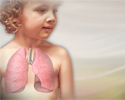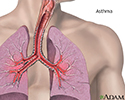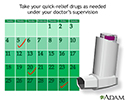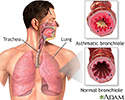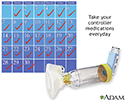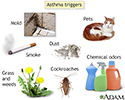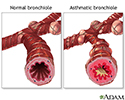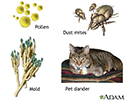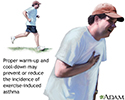Asthma
Bronchial asthma; Wheezing - asthma - adultsAsthma is a chronic disease that causes the airways of the lungs to swell and narrow. It leads to breathing difficulty such as wheezing, shortness of breath, chest tightness, and coughing.
The Basics
A Closer Look
Self Care
Asthma - Animation
Asthma
Animation
Asthma - children - Animation
Asthma - children
Animation
Asthma - Children - Animation
Asthma - Children
Health Capsule
Asthma
Asthma is a disease in which inflammation of the airways causes airflow into and out of the lungs to be restricted. The muscles of the bronchial tree become tight and the lining of the air passages swells, reducing airflow and producing the characteristic wheezing sound. This is known as an asthma attack, which can occur as an allergic reaction to an allergen or other substance (acute asthma), or as a part of a complex disease cycle which may include reaction to stress or exercise (chronic asthma).
Asthma
illustration
Asthma quick-relief drugs
Asthma quick-relief drugs work fast to control asthma symptoms. You take them when you are coughing, wheezing, having trouble breathing, or having an asthma attack. Contact your health care provider if you need them every day.
Asthma quick-relief drugs
illustration
Asthmatic bronchiole and normal bronchiole
Asthma is a disease in which inflammation of the airways causes airflow into and out of the lungs to be restricted. When an asthma attack occurs, mucus production is increased, muscles of the bronchial tree become tight, and the lining of the air passages swells, reducing airflow and producing the characteristic wheezing sound.
Asthmatic bronchiole and normal bronchiole
illustration
Asthma control drugs
Control drugs for asthma must be taken every day in order for them to work. You may need to take them more than once daily. Take them as prescribed by your health care provider.
Asthma control drugs
illustration
Asthma quick relief drugs
Asthma quick-relief drugs work fast to control asthma symptoms. You take them when you are coughing, wheezing, having trouble breathing, or having an asthma attack. Contact your health care provider if you need them every or almost every day.
Asthma quick relief drugs
illustration
Asthma control drugs
Control drugs for asthma must be taken every day in order for them to work. You may need to take them more than once daily. Take them as prescribed by your health care provider.
Asthma control drugs
illustration
Asthma triggers
It is important to know what things make your asthma worse. These are called asthma "triggers. " Avoiding them is your first step toward feeling better. The most common asthma triggers are respiratory tract infections caused by viruses such as the flu, common cold, and other viruses. Other triggers are cold and dry air, mold, pets, dust, grasses, pollen, cockroaches, odors from chemicals, and smoke from cigarettes.
Asthma triggers
illustration
Normal versus asthmatic bronchiole
During an asthma attack smooth muscles located in the bronchioles of the lung constrict and decrease the flow of air in the airways. The amount of air flow can further be decreased by inflammation or excess mucus secretion.
Normal versus asthmatic bronchiole
illustration
Common asthma triggers
Many of the same substances that trigger allergies can also trigger asthma. Common allergens include pollen, dust mites, mold and pet dander. Other asthma triggers include irritants like smoke, pollution, fumes, cleaning chemicals, and sprays. Asthma symptoms can be substantially reduced by avoiding exposure to known allergens and respiratory irritants.
Common asthma triggers
illustration
Exercise-induced asthma
Exercise-induced asthma is distinct from allergic asthma in that it does not produce long-term increase in airway activity. People who only experience asthma when they exercise may be able to control their symptoms with preventive measures such as warm-up and cool-down exercises.
Exercise-induced asthma
illustration
Asthma - Animation
Asthma
Animation
Asthma - children - Animation
Asthma - children
Animation
Asthma - Children - Animation
Asthma - Children
Animation
Asthma
Asthma is a disease in which inflammation of the airways causes airflow into and out of the lungs to be restricted. The muscles of the bronchial tree become tight and the lining of the air passages swells, reducing airflow and producing the characteristic wheezing sound. This is known as an asthma attack, which can occur as an allergic reaction to an allergen or other substance (acute asthma), or as a part of a complex disease cycle which may include reaction to stress or exercise (chronic asthma).
Asthma
illustration
Asthma quick-relief drugs
Asthma quick-relief drugs work fast to control asthma symptoms. You take them when you are coughing, wheezing, having trouble breathing, or having an asthma attack. Contact your health care provider if you need them every day.
Asthma quick-relief drugs
illustration
Asthmatic bronchiole and normal bronchiole
Asthma is a disease in which inflammation of the airways causes airflow into and out of the lungs to be restricted. When an asthma attack occurs, mucus production is increased, muscles of the bronchial tree become tight, and the lining of the air passages swells, reducing airflow and producing the characteristic wheezing sound.
Asthmatic bronchiole and normal bronchiole
illustration
Asthma control drugs
Control drugs for asthma must be taken every day in order for them to work. You may need to take them more than once daily. Take them as prescribed by your health care provider.
Asthma control drugs
illustration
Asthma quick relief drugs
Asthma quick-relief drugs work fast to control asthma symptoms. You take them when you are coughing, wheezing, having trouble breathing, or having an asthma attack. Contact your health care provider if you need them every or almost every day.
Asthma quick relief drugs
illustration
Asthma control drugs
Control drugs for asthma must be taken every day in order for them to work. You may need to take them more than once daily. Take them as prescribed by your health care provider.
Asthma control drugs
illustration
Asthma triggers
It is important to know what things make your asthma worse. These are called asthma "triggers. " Avoiding them is your first step toward feeling better. The most common asthma triggers are respiratory tract infections caused by viruses such as the flu, common cold, and other viruses. Other triggers are cold and dry air, mold, pets, dust, grasses, pollen, cockroaches, odors from chemicals, and smoke from cigarettes.
Asthma triggers
illustration
Normal versus asthmatic bronchiole
During an asthma attack smooth muscles located in the bronchioles of the lung constrict and decrease the flow of air in the airways. The amount of air flow can further be decreased by inflammation or excess mucus secretion.
Normal versus asthmatic bronchiole
illustration
Common asthma triggers
Many of the same substances that trigger allergies can also trigger asthma. Common allergens include pollen, dust mites, mold and pet dander. Other asthma triggers include irritants like smoke, pollution, fumes, cleaning chemicals, and sprays. Asthma symptoms can be substantially reduced by avoiding exposure to known allergens and respiratory irritants.
Common asthma triggers
illustration
Exercise-induced asthma
Exercise-induced asthma is distinct from allergic asthma in that it does not produce long-term increase in airway activity. People who only experience asthma when they exercise may be able to control their symptoms with preventive measures such as warm-up and cool-down exercises.
Exercise-induced asthma
illustration
Asthma
Bronchial asthma; Wheezing - asthma - adultsAsthma is a chronic disease that causes the airways of the lungs to swell and narrow. It leads to breathing difficulty such as wheezing, shortness of breath, chest tightness, and coughing.
The Basics
A Closer Look
Self Care
Asthma
Bronchial asthma; Wheezing - asthma - adultsAsthma is a chronic disease that causes the airways of the lungs to swell and narrow. It leads to breathing difficulty such as wheezing, shortness of breath, chest tightness, and coughing.
The Basics
A Closer Look
Self Care
Review Date: 1/22/2023
Reviewed By: Denis Hadjiliadis, MD, MHS, Paul F. Harron, Jr. Professor of Medicine, Pulmonary, Allergy, and Critical Care, Perelman School of Medicine, University of Pennsylvania, Philadelphia, PA. Internal review and update on 07/16/2024 by David C. Dugdale, MD, Medical Director, Brenda Conaway, Editorial Director, and the A.D.A.M. Editorial team.


